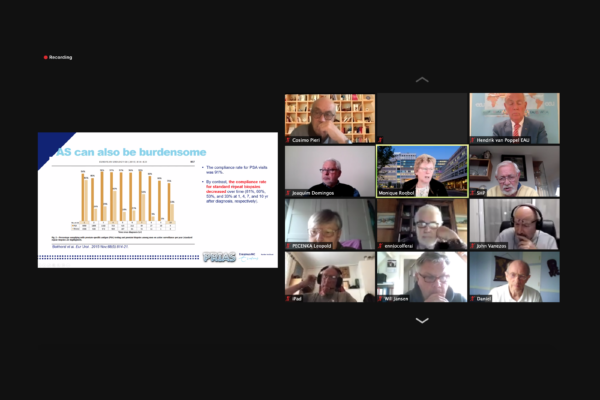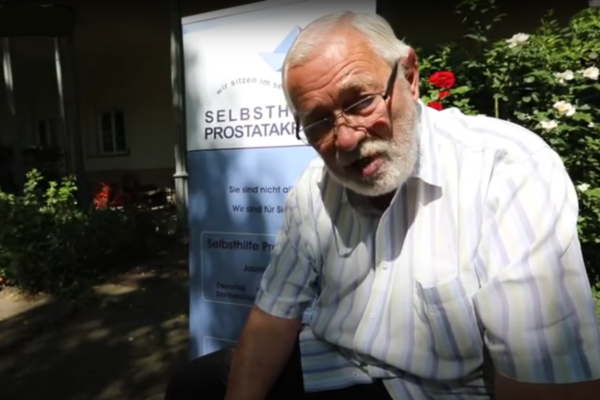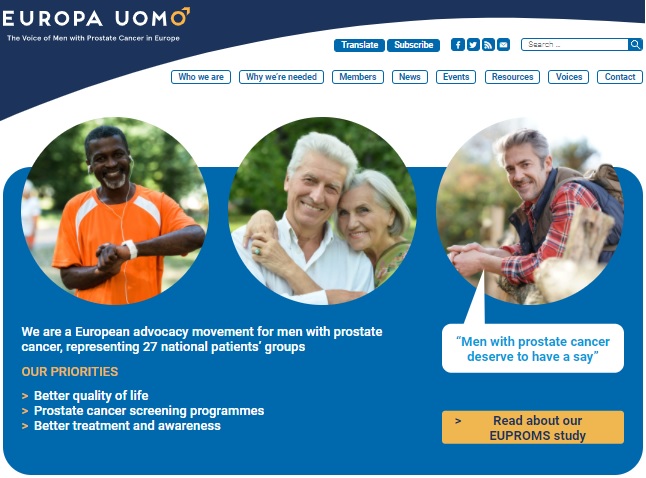|
In this issue:
|
|
|
|
|
Active surveillance is safe and effective, webinar hears
Europa Uomo event discusses experiences and future developments
|
|
|
|
|
Austrian urologists adopt early detection formula
Proposals from EAU and Europa Uomo also being considered by EU
|
|
|
|
|
Action urged for cancer patients during COVID
Europa Uomo signs joint letter offering support to governments
|
|
|
Prostate Research and Treatments
Apalutamide Benefit in mCSPC patients
The final results from the phase 3 TITAN Study confirm the benefit of Apalutamide in cases of Metastatic Castration Sensitive Prostate Cancer. This survival benefit comes from adding apalutamide to standard care for metastatic castration-sensitive prostate cancer (mCSPC) and it persisted at nearly 4 years of follow-up, . In the final analysis, the risk of death with apalutamide was reduced by 35%…“ said Dr. Kim N. Chi, MD, a medical oncologist at British Columbia Cancer, Vancouver Prostate Centre. He reported these results at the 2021 Genitourinary Cancer Symposium (GuCS). The international, double-blind TITAN trial compared apalutamide with placebo, both added to standard ADT, in 1,052 men with mCSPC, including those with high- and low-volume disease, prior docetaxel use, prior treatment for localized disease, and prior ADT for no more than 6 months.
At the final analysis, the median treatment duration was 39.3 months for the apalutamide arm, 20.2 months for the placebo arm, and 15.4 months for men who crossed over from placebo to apalutamide. “After adjusting for crossover, the effect of apalutamide on Overall Survival increased indicating a reduction in the risk of death by 48% vs. placebo,” Dr. Chi said.
Read more (pages 2 & 6).
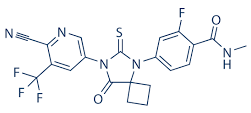 |
|
|
Machine Learning in Prostate Cancer Diagnosis
This is a systematic literature review into the Machine Learning Method Performance for Prostate Cancer Diagnosis.
Machine learning algorithms have been attracting attention at the cross over of pathology and radiology in prostate cancer research and diagnosis. This study, by R Castaldo and others, assesses the source of differences and performance of machine learning applied to radiomic, genomic, and clinical biomarkers for the diagnosis of prostate cancer. The sheer volume of data to be analysed can very considerable and machine learning or as some might term it – the number crunching – has proved of considerable assistance to researchers. This study was focussed on clearly identifying problems and issues related to the implementation of machine learning in clinical studies.
The performance of machine learning for diagnosis of prostate cancer was considered satisfactory for several studies investigating the multiparametric magnetic resonance imaging and urine biomarkers; however, given the limitations in the study admitted by the authors further work is needed to establish the potential use of machine learning to clinical settings.
Studies that used machine learning to detect prostate cancer and provided performance measures were included in Dr Castalso’s analysis. The analysis of machine learning methods to detect prostate cancer reveals the limited usage of the methods and the lack of standards that hinder the implementation of machine learning in clinical applications.
See paper published in April 2021 at Journal of Medical Internet Research – Vol 23, No 4 (2021): April (jmir.org)
See also the Prostapedia Report.
|
|
|
Europa Uomo News
Second Active Surveillance Webinar After Successful Launch
Speakers: Prof. Hein Van Poppel, Prof. Monique Roobol & Cosimo Pieri
We would like to urge all member organisations to draw the attention of their members to the video of the Active Surveillance Webinar held on 20 April. The website has a link and for the convenience of readers we have the link below. The history of overtreatment in the previous 30 years was clearly analysed by Hein Van Poppel and the moves now being made by the clinicians to identify low risk prostate disease and the role of active surveillance as a treatment for men with concerns about their low risk prostates. In a very clear presentation on the value of active surveillance and transformation of early detection in recent years, Monique Roobol explained the value of active surveillance and the benefits of the treatment even for those men who subsequently move to active treatment. The Patient Perspective was ably delivered by Cosimo Pieri.
Click on this link to access the webinar video: Active Surveillance Zoom Webinar 1 – YouTube
The second webinar on Active Surveillance will be held on Thursday 20th May, 1800-1900 CET. Speakers will include: Ioannis Vanezos, who will speak of his personal experience of AS; Professor Riccardo Valdagni, a radiation oncologist and AS expert: and Dr Lara Bellardita, a clinical and health psychologist and psychotherapist.
Register in advance here. After registering, you will receive a confirmation email containing information about joining the meeting.
 |
|
|
Transperineal or Transrectal Biopsy for Prostate Cancer?
The ASPI Webinar last week was more narrowly focussed than its previous events in dealing with the changes taking place in prostate biopsies. There are two important points to be made here, Firstly, because of existing and forthcoming developments likely by the end of this decade, if not before, we can reasonably expect prostate cancer to become mainly a disease of men who are treated with active surveillance where biopsies loom large for patients and these number are being reflected in the composition of our patient organisations. On the Europa Uomo Board at present 3 of the 7 members (43%) are Active Surveillance patients.
Secondly: rather than being seen as a sort of waiting room before treatment Active Surveillance will be fully recognised by medical practitioners, specialists in prostate research and decision makers in government as the way we will manage early detected and low risk prostate cancers in the coming years and the increases in early detection are taking place in Europe at a rate that is very rapid for what is normally regarded as a conservative profession in terms of clinical practices. This is due to champions of change such as Chris Chapple, Hein Van Poppel, and others in the EAU and ESMO and others, as well as the readiness of patient organisations nationally like Austria, Finland, Germany and Italy and others and on the European stage Europa Uomo, ECPC and others.
The frank responses of the clinicians and especially the question and answer session which was wisely extended is a must view. When the video of the meeting is available we will post it on our Website.
|
|
|
Austrian Urologists Embrace the European Approach to Early PCa Detection
Our dear colleague from Austria, Ekke Büchler Buchler, has brought us the good news that the urologists in Austria have agreed to adopt the algorithm for early detection being advocated by the EAU and EUomo. Please see a fuller report at the beginning of this Issue of Update.
|
|
|
General Assembly 2021 - Motions, Candidates for the Board, etc.
Candidates for Board membership:
Member organisations are now invited to submit nominations of candidates for election to the Board. There are two positions to be filled at the General Assembly, as these two new Board positions have no incumbents having been created by the General Assembly last year and filled for the first time this year.
Any member organisation wishing to make a nomination should do so by e-mail to the Secretariat not later than May 15th 2021, together with a CV or Résumé and a short statement of motivation indicating what the candidate believes he/she will bring to the Board of Europa Uomo. The nominee should also indicate their acceptance of the nomination. Each candidate will be given time to address the GA before the election.
Motions for the General Assembly:
Any member organisation that wishes to submit a motion for the agenda should submit the terms of the motion to the Secretariat by e-mail. The notice of motion should be signed by the Chairman, Secretary and an ordinary member and received by the Secretariat not later than May 15th 2021.
Should any member organisation wish to amend the Bye-laws they should submit the Bye-law they seek to alter, insert or delete and the wording of any resultant change not later than May 15th 2021.
Any organisation seeking to amend a Statute or statutes must secure the support of one fifth of member organizations. See statutes for details.
 |
|
|
Europa Uomo Website
Have you looked at the Europa Uomo Website this week?
It has many features you or your members can use
• Items can be translated into one of 17 languages by using the facility on the site.
• You can submit items to the Website or the Update in any one of the 17 languages and we will do the translation if accepted we will publish your article in English and in your own language.
• You can access back issues of the Update. We are fast approaching 150 issues since we first launched the Update in 2018.
• The website carried stories on happenings of interest to prostate cancer patients.
• Most importantly both the website and Update has many links to other organisations and publications
|
|
|
Exercise & Nutrition for Prostate Cancer Patients
Foods that fight inflammation
In this issue we are please to launch a regular feature on Exercise and Nutrition for Prostate Cancer Patients.
Our first items are an article based on a publication from Harvard Medical School’s publishing arm which deals with the notion of an anti-inflammatory diet. Before you groan, this writer can confirm the beneficial effects of an anti-inflammatory diet for the last 8 months in terms of weight loss, plunging blood sugar levels to normal and phasing our medication for type II diabetes – one of the most widespread afflictions in the wealthier world. This kind of diabetes can often be brought on in prostate cancer patients on Androgen Deprivation Treatment as weight gain is often one of the side effects of ADT.
We also provide an introduction to an article from the New England Journal of Medicine on Obesity, Immunity and Cancer. It is not too full of medical jargon and most readers should have little problem following it.
1. Foods that fight inflammation
Doctors are learning that one of the best ways to reduce inflammation lies not in the medicine cabinet, but in the refrigerator. By following an anti-inflammatory diet you can fight off inflammation for good.
What does an anti-inflammatory diet do? Your immune system becomes activated when your body recognizes anything that is foreign—such as an invading microbe, plant pollen, or chemical. This often triggers a process called inflammation. Intermittent bouts of inflammation directed at truly threatening invaders protect your health.
However, sometimes inflammation persists, day in and day out, even when you are not threatened by a foreign invader. That’s when inflammation can become your enemy. Many major diseases that plague us—including cancer, heart disease, diabetes, arthritis, depression, and Alzheimer’s—have been linked to chronic inflammation.
One of the most powerful tools to combat inflammation comes not from the pharmacy, but from the grocery store. “Many experimental studies have shown that components of foods or beverages may have anti-inflammatory effects,” says Dr. Frank Hu, professor of nutrition and epidemiology in the Department of Nutrition at the Harvard School of Public Health.
To learn which foods to choose and reduce your risk of aggravating your cancer or starting to show signs of the most insidious additional disease for prostate cancer patients have a look at the attached article by clicking here.
 |
|
|
Obesity, Immunity, and Cancer
“Obesity, which is increasing to epidemic proportions, is strongly associated with increased susceptibility to a variety of diseases.” These few words from a recent article in the NEJM encapsulate nature, scale and impact of the problem. The observation that obesity can promote inflammation was first reported nearly 30 years ago. The article goes on to spell out that an obese person is open to a range of disease due to inflammation.
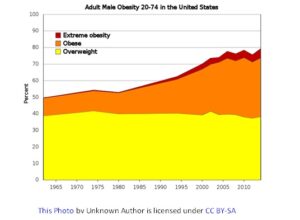
Obesity and its systemic effects and induce changes in T-cell and macrophage populations and promote subsets of these cells which can be inflammatory. Because T-cells are part of the body’s self-defence system the potential knock-on effects when they become inflamed can be severe. This kind of inflammation is most apparent in adipose tissue and can make worse a wide range of diseases including type II diabetes.
The effect of obesity on cancer and the immune cells in the tumour micro-environment has been thought to influence two or more seemingly unrelated types of cell and helping cancer cells to grow out of control. Obesity, however, is a setting of nutrient abundance, and the ways in which cancer cells and T cells adapt and interact with altered nutrients remain poorly understood.
Read more.
 |
|
|
Items of Interest
From Jenner's Cowpox to mRNA Covid Vaccines
This article from the NEJM is the story of viruses and vaccinations since the first vaccine-related advance in 1796. It provides a ready understanding of the role of mRNA vaccines in the current viral pandemic. The passage of two hundred and twenty five years since Edward Jenner, a physician working in southern England, didn’t know of the existence of viruses, but through observation and daring experimentation he found what we now call a vaccine. Smallpox was a major killer and/or disfiguring disease at the time. Nevertheless, the notion that infectious diseases could be prevented by vaccination was born. Jenner’s work ultimately led to the eradication of a disease that is estimated to have killed more than 300 million people in the 20th century.
The following milestones illustrate the development of vaccines and other developments:
• 1885 rabies treated by Louis Pasteur
• 1937 Max Theiler treats Yellow Fever with virus grown in non-hum embryos
• 1940s Thomas Francis develops a vaccine for influenza
• 1950s Sabin vaccines developed for polio.
• 1960s Vaccines for measles, mumps and rubella and Salk polio vaccine.
• 1986 Hepatitis B vaccination,
• 2006 human papillomavirus vaccine which may eliminate cervical cancer
• 2010s influenza and Ebola vaccines
• 2020 Covid-19 vaccines in the current pandemic
Read more.
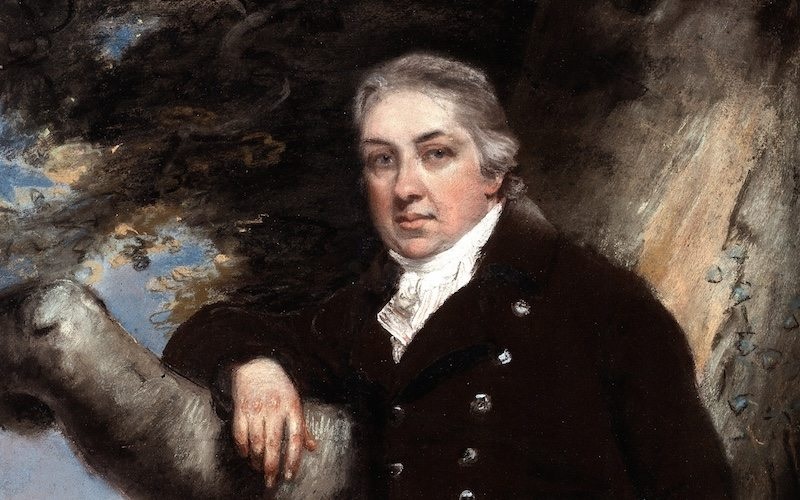 |
|
|
|
|
|
FREE SUBSCRIPTION TO EUROPA UOMO MONTHLY UPDATE
All previous issues are available on website: www.europa-uomo.org/newsletters/
|
|
